![]()
![]()
![]()
Use LEFT and RIGHT arrow keys to navigate between flashcards;
Use UP and DOWN arrow keys to flip the card;
H to show hint;
A reads text to speech;
57 Cards in this Set
- Front
- Back
|
How does most life on earth acquire energy?
|
Photosynthesis (directly or indirectly) followed by cellular respiration. These processes form a cycle on which life depends.
|
|
|
Respiration
|
Complete breakdown of organic fuel, produces more ATP.
|
|
|
Fermentation
|
Incomplete breakdown of organic fuel, produces less ATP.
|
|
|
What happens to the organic fuel in catabolism?
|
It is oxidized.
|
|
|
Oxidation
|
Loss of electrons.
|
|
|
Reduction
|
Gaining of electrons.
|
|
|
What do redox reactions involve?
|

A transfer of electrons.
In the picture, the energy is formed from the potential energy of the electrons. |
|
|
What stores energy?
|
Electrons
Fats Carbs Fats store more energy than carbs. |
|
|
Is ATP synthesis exergonic or endergonic?
|
Endergonic, it requires energy to make ATP. The energy comes from the substrate.
|
|
|
Is cellular respiration exergonic or endergonic?
|
Exergonic.
|
|

Before H's are transferred... where are they first transferred to?
|
Coenzymes.
|
|
|
Coenzymes
|
Small molecule required by some enzymes.
Like the substrate: --Bind to the enzyme --Chemically altered Serve as 'molecular handles' Ex: NAD+, FAD, Coenzyme A |
|
|
Main coenzyme is NAD+ (nicotinamide adenine dinucleotide)
|
carries hydrogen
-- specifically: 2e− + 1 p+ reduced form is: NADH KEY: little energy is lost! a "dinucleotide‟ |
|

Cellular Respiration overview
|
glucose has HIGH ENERGY electrons
glucose is oxidized by oxygen e−+ p+ (hydrogen) are transferred to oxygen H‟s FIRST transferred to NAD+ making NADH |
|
|
Four Stages of Cellular Respiration
|
1) Glycolysis
2) Pyruvate Oxidation 3) Citric Acid Cycle 4) Electron Transport |
|
|
Overview of Stages 1-4
|
(1-3) catabolize glucose through oxidations, makes a little ATP
-- many NAD+s are reduced (4) electrons are transferred, makes most ATP -- NADHs are oxidized |
|
|
In Stage 1: Glycolysis
|
10 step pathway
Begins in cytosol Breaks glucose into 2 smaller molecules. |
|
|
Energy Investment Phase (uses ATP): Steps 1-5 in Glycolysis
|
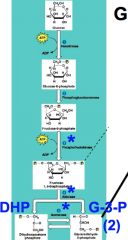
Step 1: Two reactants: glucose and ATP. Product: ADP.
Step 2: Converts glucose to fructose. Step 3: Use ATP to phosphorylate the sugar. Phosphofructosekinate (PFK) Step 4: Glycolysis (breaks sugar into DHP and G-3-P) Step 5: Converted DHP into G-3-P so there is now 2. |
|
|
Energy Payoff (creates ATP): Steps 6-10 in Glycolysis
|

Step 6: 2 G-3-P + 2NAD+ -> 2NADH + 2H+
G-3-P is oxidized. Step 7: Makes ATP Step 8: Rearranging molecule Step 9: Catabolizes Step 10: Makes more ATP. Final product: pyruvate. |
|
|
Substrate-level phosphorylation
|
Making ATP by transferring a phosphate from an organic substrate, to ADP.
|
|
|
Tabulation of glycolysis
|
2 Pyruvate
4 ATP per glucose 2 produced per G-3-P Net: 2 ATP per glucose Other products: 2 NADH per glucose |
|
|
In Stage 2: Pyruvate oxidation
|
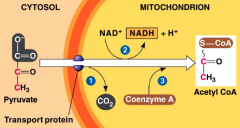
Pyruvate is transported into the mitochondrial matrix.
Three step pathway. Catalyzed by a complex of enzymes. Coenzyme A receives the acetyl group. |
|
|
In Stage 3: Citric Acid Cycle
|
Eight Step Pathway
A Cycle Completes glucose catabolism Hans Krebs |
|
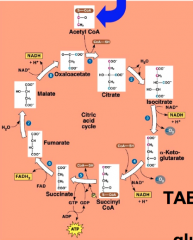
Citric Acid Cycle (cont.)
|
Acetyl CoA + oxaloacetate -> citrate
made 4 ATP, 10 NADH, 2 FADH2 1 ATP per cycle -686 kcal/mol Most of the harvested energy from glucose in NADH now NADH is oxidized by an electron transport chain |
|
|
ATP synthase
|
Makes ATP. Embedded into the membrane of the mitochondria. Power provided by proton gradient.
|
|
|
In Stage 4: Electron Transport
|
A 'chain' of proteins within the inner membrane
Includes 4 complexes Several 'cytochrome proteins' Chain preforms a series of redox reactions: electron transport chain |
|
|
Electron Transport (cont.)
|
The chain is oxidized by oxygen
Flavoprotein in complex I -> cytochromin 3 in complex IV |
|
|
Electron Transport (cont.):
The last redox reaction (for 2 NADH): 4e- + 4H+ + O2 -→ 2H20 |
Energy poor, greater electronegativity.
Consumed ALL reactants. Generated: both chemical byproducts, 4ATP per glucose Electrons are at an energy minimum in water. |
|
|
What do the chain proteins transfer?
|
Protons, across the inner membrane, creating a proton gradient (energy). Use the energy of redox.
Used to make ATP by the enzyme ATP synthase. |
|
|
Chemiosmosis
|
Using a proton gradient to make ATP.
|
|
|
Oxidative phosphorylation
|
Making ATP from ADP and Pi, powered by redox reactions of an electron transport chain.
|
|
|
Electron transport chain + chemiosmosis = ?
|
Oxidative phosphorylation
|
|
|
Path of Energy Flow
|
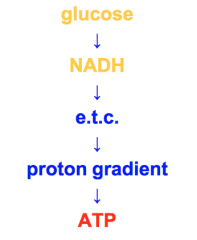
|
|
|
Final ATP tabulation
|
Glycolysis: 2
Citric acid cycle: 2 Oxidation phosphorylation: 26 Total: 30 |
|
|
How efficient is cellular respiration?
|
32%-40%. Pretty efficient.
|
|
|
What if the oxidizing agent 02 is unavailable?
|
They can't get rid of electrons.
1) Chain fills with e-, stops functioning 2) NADH has no oxidizing agent. Can't make NAD+, becomes depleted 3) The solution is fermentation |
|
|
Two types of fermentation
|
Lactic acid, and alcohol fermentation.
|
|
|
Fermentation
|
A catabolism without O2 (incomplete)
Derive ATP from glycolysis only Oxidize NADH using pyruvate Microorganisms do this in an oxygen deprived environment. We do this in our muscles. |
|
|
What runs cellular respiration?
|
Bacteria and yeast
|
|
|
What fuels cellular respiration?
|
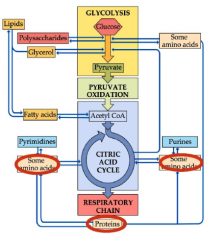
Carbs- fructose, sucrose, maltose, lactose, starch
Fats- fatty acids, glycerol Proteins- amino acids |
|
|
How is cellular respiration regulated?
|
Through the enzyme PFK (phosphofructosekinase).
|
|
|
PFK
|
Catalyzes the third step of glycolysis
Has allosteric sites Can be positively or negatively regulated Controlled by feedback inhibition |
|
|
What can PFK be shut off by and promoted by?
|
Shut off by: ATP & citrate
Promoted by: ADP & AMP |
|
|
Coenzymes may be made from __________. An example is NAD+, which is made from nicotinic acid or niacin.
|
Vitamins.
|
|
|
What coenzyme is used as an oxidizing agent during the first three stages of cellular respiration?
|
NAD+
|
|
|
How many different enzymes run the citric acid cycle?
|
8
|
|
|
Which of the first three stages of cellular respiration does NOT produce ATP?
|
Pyruvate oxidation.
|
|
|
Which of the first three stages of cellular respiration does not produce NADH?
|
All produce NADH.
|
|
|
Enzymes or other proteins involved in a metabolic pathway may be LOCALIZED so that they function more efficiently or in specialized capacities. The following are examples from cellular respiration:
|
-the enzymes of pyruvate oxidation are bound together into a multi-enzyme
complex -citric acid cycle enzymes are located in the mitochondrial matrix -electron transport chain proteins and ATP synthase are embedded in the inner membrane of the mitochondria |
|
|
What type of gradient is created across the mitochondrial inner membrane during the last stage of cellular respiration?
|
Proton gradient.
|
|
|
In which subcellular compartment specifically are protons concentrated during cellular respiration?
|
Mitochondrial intermembrane space. A mitochondrion only has TWO membranes and TWO aqueous compartments.
|
|
|
The TRANSFORMATION of the energy of a proton gradient into the energy of ATP is a demonstration of the _______
|
First law of thermodynamics.
|
|
|
In addition to being an enzyme, ATP synthase is a _____.
|
Membrane transport protein.
|
|
|
The following reaction occurs during cellular respiration:
1, 3-bisphosphoglycerate + ADP → 3-phosphoglycerate + ATP The reaction shown occurs _____. |
During glycolysis.
|
|
|
This reaction is an example of _____.
|
Substrate level phosphorylation.
|
|
|
ATP is made in the above reaction because energy is provided by _____.
|
1, 3-bisphosphoglycerate.
|
|
|
The synthesis of ATP by the enzyme ATP synthase works differently than the reaction above, and involves the flow of protons across the mitochondrial inner membrane THROUGH the enzyme itself. This movement of protons is best termed as _____.
|
Facilitated diffusion.
|

